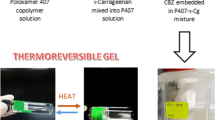Abstract
Purpose. This study characterizes the in vivoproperties of an in situforming gel, comprising an IPC of water-soluble polymers, PMA and PEG, for sustained release of macromolecular drugs.
Methods. 40, 50 or 60% w/v formulations were injected subcutaneously in a rat model either alone, or containing model macromolecules, 3A2-ATG-psODN or REV-psODN, to (i) determine the approximate gelling and residence time of the gel at the site of injection, (ii) assess the biological efficacy of the formulation using a MZ sleep time model, and (iii) demonstrate specificity of the sequence and selectivity of the psODNs by measuring changes in microsomal enzyme levels and urine volumes.
Results. A sol to gel transition requires 15 min in vivo, and the 60% w/v IPC gel remains at the site of injection for up to 72 hr. The MZ sleep times and CYP3A2 expression due to 3A2-ATG-psODNs released from the gel are significantly different compared to that of REV-psODNs.
Conclusions. The IPC solutions exhibit phase transformation in vivo, and demonstrate no evidence of toxicity. The pharmacological effects observed from the of release of 3A2-ATG-psODNs suggest that the formulation can entrap, protect, and sustain the delivery of macromolecules.
Similar content being viewed by others
REFERENCES
T. Tice and S. Tabibi. Parenteral Drug Delivery: Injectables. In A. Kydonieus (eds). Treatise on Controlled Drug Delivery, Marcel Dekker, Inc., 1992. pp. 319-336.
A. Kharenko and V. Kemenova. Controlled release from oral formulations based on interpolymeric polymethacrylic-polyethylene glycol complex. Proceed. Intern. Symp. Control. Rel. Bioact. Mater. 22:232 (1995).
C. Bell and N. Peppas. Poly(methacrylic acid-g-ethylene glycol) hydrogels as pH responsive biomedical materials. Mat. Res. Soc. Symp. Proc. 331:199-204 (1994).
B. Haglund, R. Joshi, and K. Himmelstein. An in situ gelling system for parenteral delivery. J Control. Rel. 41:229-235 (1995).
M. Shively, B. Coonts, W. Renner, J. Southard, and A. Bennett. Physico-chemical characterization of a polymeric injectable implant delivery system. J Control. Rel. 33:237-243 (1995).
W. Lambert and K. Peck. Development of an in situforming biodegradable polylactide-co-glycolide system for the controlled release of proteins. J. Control. Rel.189-195 (1995).
J. Desjardins and P. Iversen. Inhibition of the rat cytochrome P450 3A2 by an antisense phosphorothioate oligodeoxynucleotide in vivo. J. Pharmacol. Exp. Ther. 275:1608-1613 (1995).
K. Thummel, D. Shen. T. Podoll, K. Kunze, W. Trager, P. Hartwell, V. Raisys, C. Marsh, J. McVicar, D. Barr, J. Perkins, and R. Carithers Jr. Use of midazolam as a human cytochrome P450 3A probe. J. Pharmacol. Exp. Ther. 271:549-556 (1994).
P. Watkins. Non-invasive test of CYP3A enzymes. Pharmacogenetics 4:171-184 (1994).
J. Desjardins, B. Sproat, B. Beijer, M. Blaschke, M. Dunkel, W. Gerdes, J. Ludwig, V. Reither, T. Rupp, and P. Iversen. Pharmacokinetics of a synthetic, chemically modified hammerhead ribozyme against the rat cytochrome P-450 3A2 mRNA after single intravenous injections. J. Pharmacol. Exp. Ther. 278:1419-1427 (1996).
M. Franklin and R. Estabrook. On the inhibitory action of mersalyl on microsomal drug oxidation: A rigid organization of the electron transport chain. Arch. Biochem. 143:318-329 (1971).
M. Bradford. A rapid and sensitive method for the quantification of microgram quantities of protein utilizing the principle of protein-dye binding. Anal. Biochem. 72:248-254 (1976).
F. Gonzalez. The molecular biology of the cytochrome P450s. Pharmacol. Rev. 40:243-287 (1989).
T. Nash. The colorimetric estimation of formaldehyde by means of the Hantzsch reaction. Biochem. J. 55:416-421 (1953).
M. Burke, S. Thompson, C. Elcombe, J. Halpert, T. Haaparanta and R. Mayer. Etoxy-, Pentoxy-, and benzyloxyphenoxazones and homologues: A series of substrates to distinguish between different induced cytochrome P450s. Biochem. Pharmacol. 34:3337-3345 (1985).
L. Reinke and M. Moyer. P-nitrophenol hydroxylation a microsomal oxidation which is highly inducible by ethanol. Drug Metab. and Disp. 13:548-552 (1985).
J. Nishikawa, T. Yabe, A. Kast, and H. Albert. Circadian rhythm of the liver of male rats pre-treated with phenobarbital-II. Hexabarbital sleeping times and lipid contents in liver and serum. Chronoiol. Inter. 4:175-182 (1987).
P. Robel, E. Baulieu, M. Synguelakis, and F. Halberg. Chronobiologic dynamics of Δ5-3b-hydroxysteriods and glucocorticoids in rat brain and plasma and human plasma. Prog. Clin. Biol. Res. 227A:451-465 (1987).
D. Simmons, McQuiddy, and C. Kasper. Induction of the hepatic mixed-function oxidase system by synthetic glucocorticoids. J. Biol. Chem. 262:326-332 (1987).
M. Paine, D. Shen, K. Kunze, J. Perkins, C. March, J. Mc Vicar, D. Barr, B. Gillies, and K. Thummel. First-pass metabolism of midazolam by the human intestine. Clin. Pharmacol. Ther. 60(1):14-24 (1996).
K. Thummel, D. O'Shea, M. Paine, D. Shen, K. Kunze, J. Perkins, and G. Wilkinson. Oral first-pass elimination of midazolam involves both gastrointestinal and hepatic CYP3A-mediated metabolism. Clin. Pharmacol. Ther. 59(5):491-502 (1996).
M. Paine, D. Shen, K. Kunze, J. Perkins, C. March, J. McVicar, D. Barr, B. Gillies, and K. Thummel. First-pass metabolism of midazolam by the human intestine. Clin. Pharmacol. Ther. 60(1):14-24 (1996).
K. Thummel, D. O'Shea, M. Paine, D. Shen, K. Kunze, J. Perkins, and G. Wilkinson. Oral first-pass elimination of midazolam involves both gastrointestinal and hepatic CYP3A-mediated metabolism. Clin. Pharmacol. Ther. 59(5):491-502 (1996).
Author information
Authors and Affiliations
Rights and permissions
About this article
Cite this article
Joshi, R., Arora, V., Desjardins, J.P. et al. In Vivo Properties of an In Situ Forming Gel for Parenteral Delivery of Macromolecular Drugs. Pharm Res 15, 1189–1195 (1998). https://doi.org/10.1023/A:1011979505697
Issue Date:
DOI: https://doi.org/10.1023/A:1011979505697




